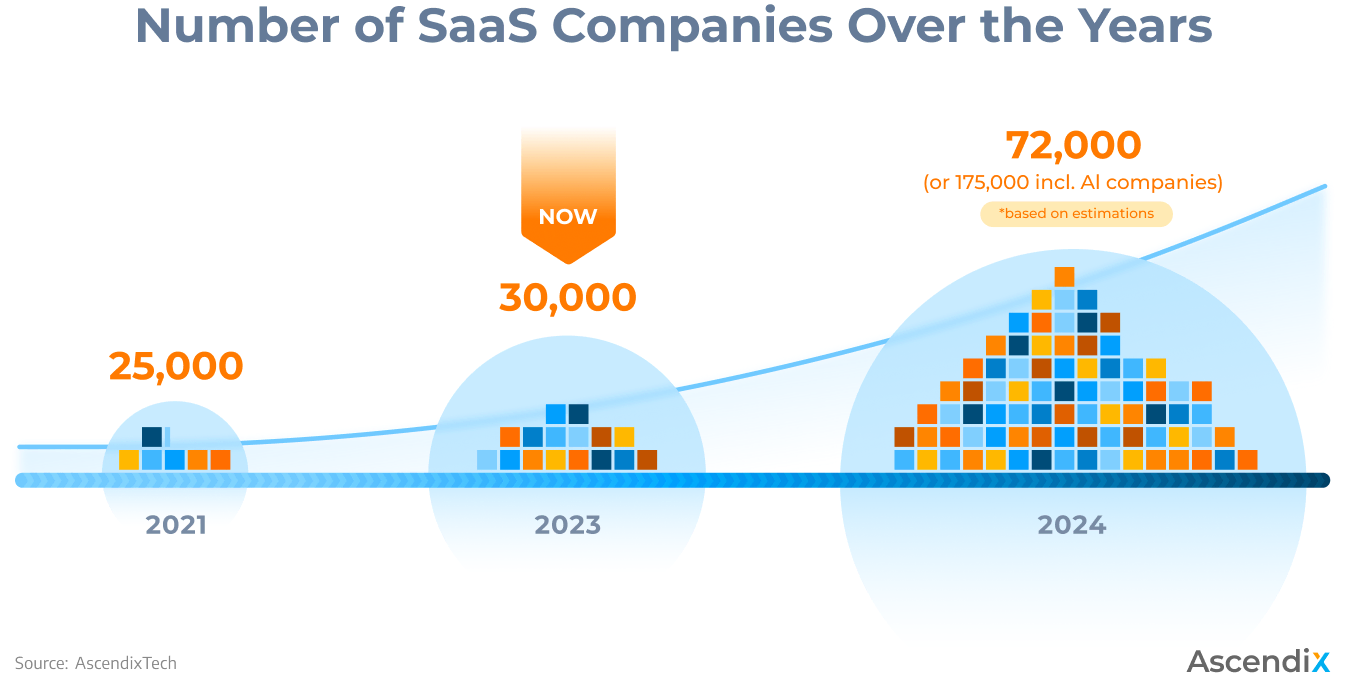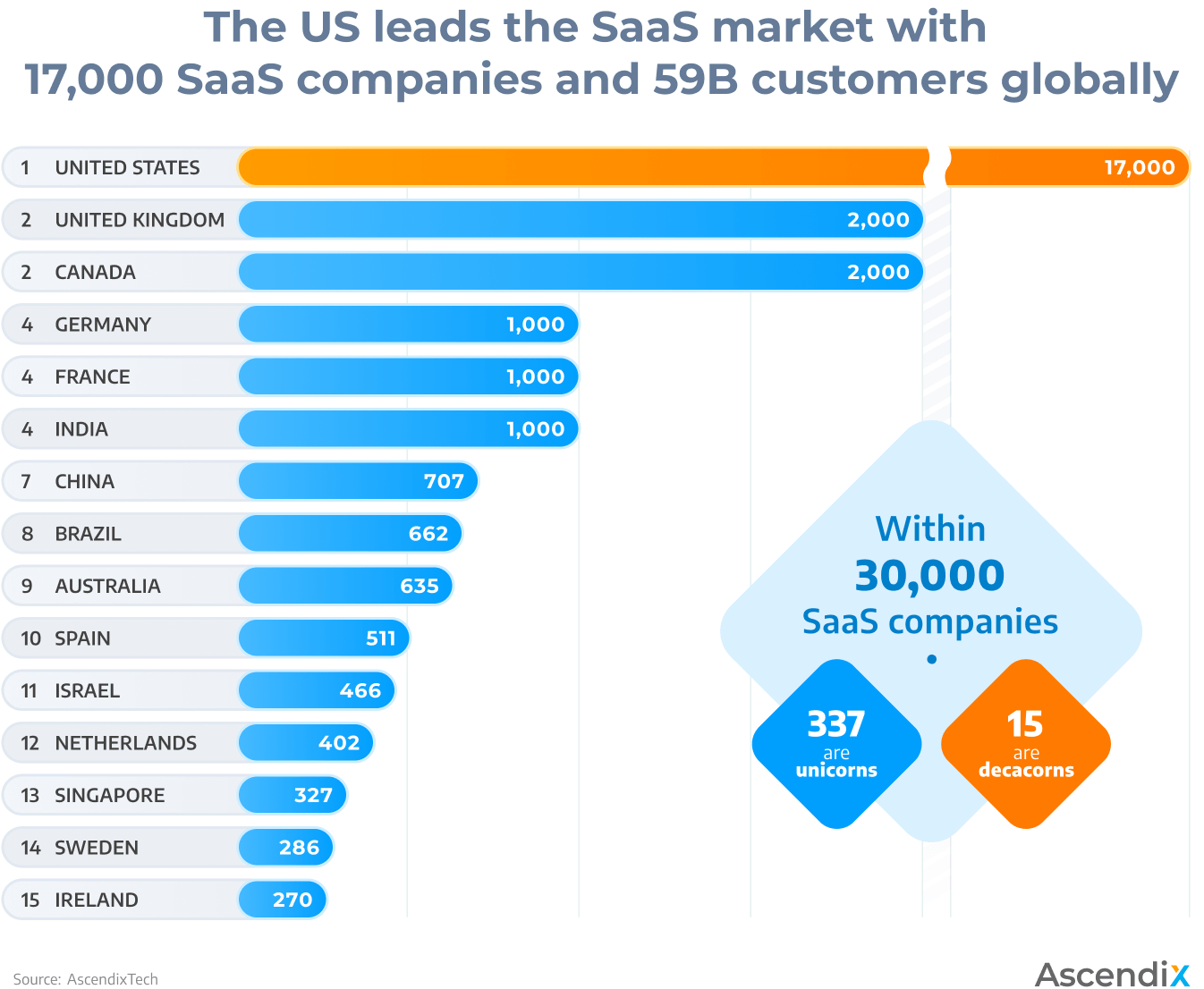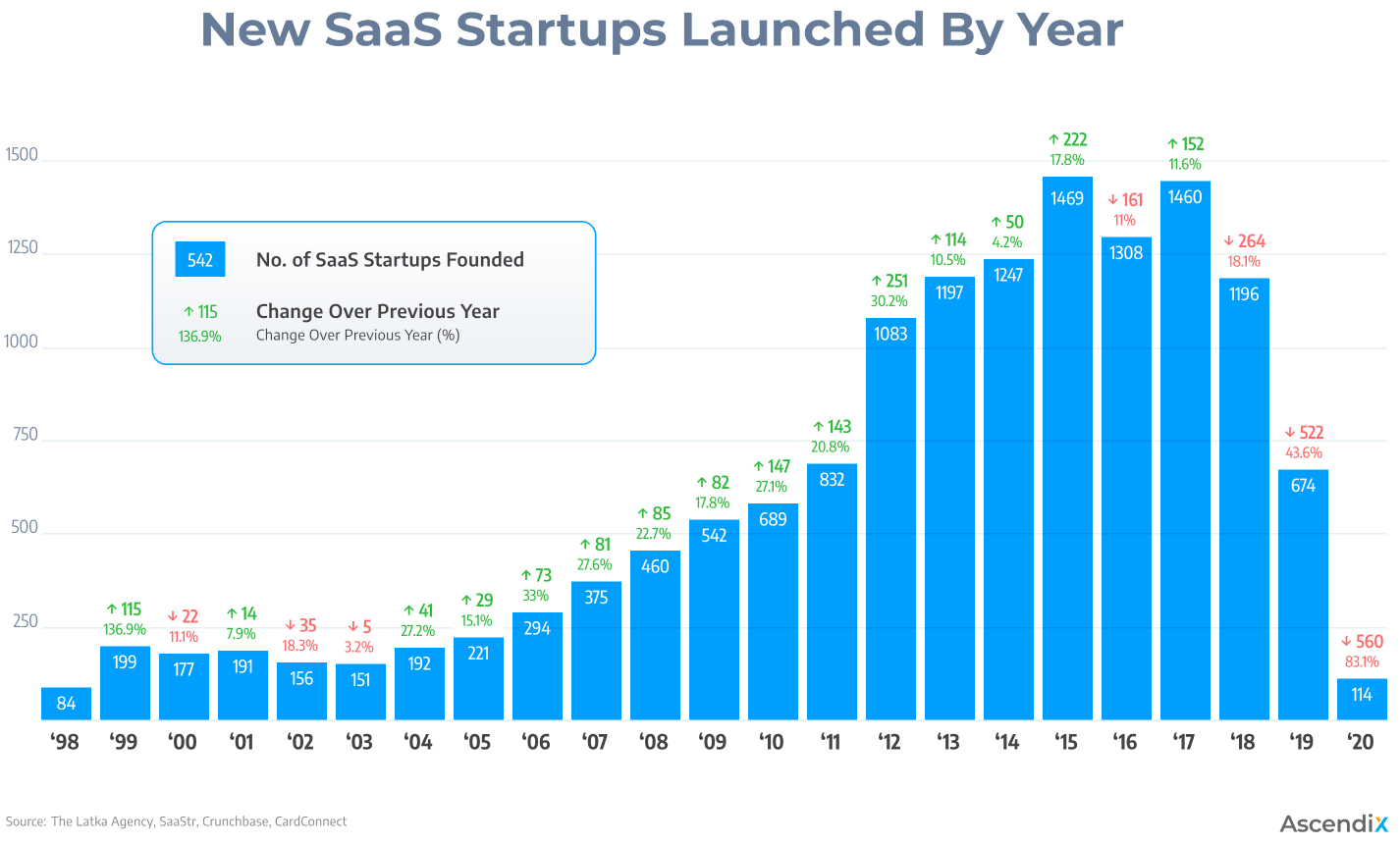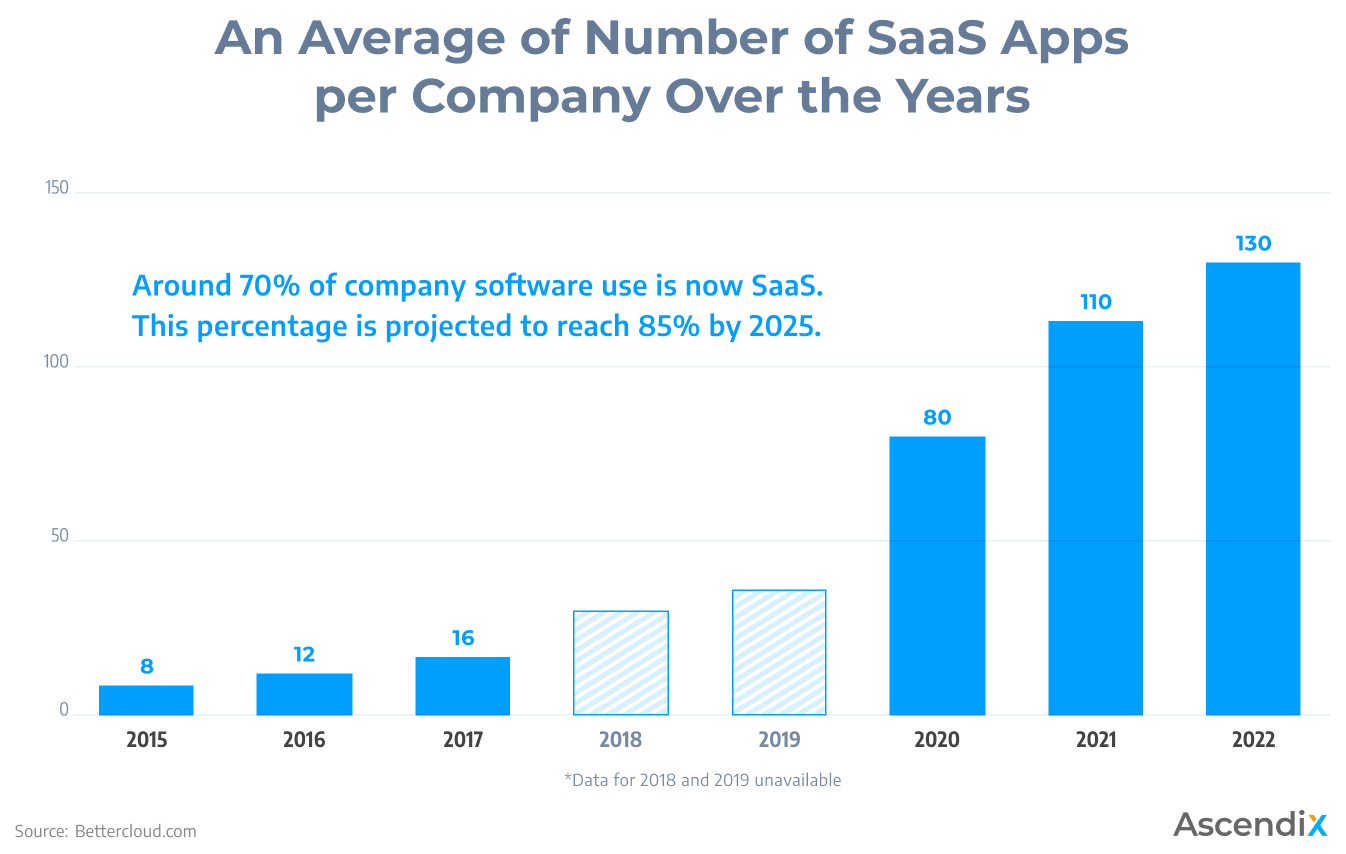“ SaaS spend is driven by applications being modernized by independent software vendors to run in a SaaS-based consumption model. Organizations continue to increase their usage of cloud for specific use cases such as AI, machine learning, Internet of Things and big data which is driving this SaaS growth. ”
At the beginning of 2025, there were over 30,800 SaaS companies serving millions of customers.
The market size of SaaS is projected to reach $700 billion by 2030, with a CAGR of 18.3% from 2022 to 2030. The United States holds the largest share of the global SaaS market, accounting for over 17,000 companies. At the forefront of this booming industry is the world’s largest SaaS company, Salesforce, which generated over $34 billion in revenue in 2024.
Below, we will provide an overview of the key statistics on SaaS, including SaaS market size, growth rate, number of Saas companies by region, and the top SaaS companies among them.
Table of Contents:
The Number of SaaS Companies | SaaS Statistics 2025
The number of SaaS companies in the world at the end of 2024 was over 30,800, according to a Statista report on SaaS organizations by country (Source). SaaS is currently responsible for around 70% of company software use. This figure is forecast to rise to 85% in 2025.
By the end of 2024, there were around 72,000 SaaS companies in operation. Additionally, the SaaS market is predicted to reach a valuation of $307 B by 2026. However, this estimate doesn’t account for companies specializing in artificial intelligence, which could increase the number to 175,000.

Number of SaaS Companies Over the Years
These SaaS companies operate in various segments, with over 24,000 Productivity Tools and Collaboration Applications alone.
Additionally, there are about 17,000 companies like Salesforce in the Customer Service Solutions segment, 15,000 in Marketing Software, nearly 14,000 in E-commerce, and 12,000 in Data & Analytics. Sales come in at 11,500 companies (these estimations include AI companies).

SaaS Companies by Industry
Number of SaaS Companies by Country
According to Statista, the leading country by number of SaaS companies is the United States, with a staggering 17,000 (around 60%) SaaS companies and 59 million customers globally, followed by the United Kingdom with approximately 1,500 SaaS companies, Canada with 992 SaaS companies, Germany with 840 SaaS companies, France with 684 SaaS companies, and India with 711 SaaS companies.
These firms include established companies such as Dropbox and Adobe Creative Cloud, as well as small startups.

Number of SaaS Companies by Country
In fact, the US has over 8 times more (9,100) SaaS companies than any other country. In the USA, Silicon Valley is the hub for top enterprise SaaS companies and products (Google Workplace, HubSpot, Jira, Slack, Atlassian, GitHub, Figma, Salesforce, Xero, Zoom), with two-thirds of the top 100 located there.
The top five SaaS companies in the USA (Microsoft, Salesforce, SAP, Oracle, Google) are located in California, Washington, New York, Massachusetts, and Utah.
Europe altogether has a rapidly growing number of SaaS companies, with countries such as the UK, Germany, and France leading the way. Following the US is the United Kingdom, with 2,000 companies and 3 billion customers.
The UK’s SaaS market was valued at $17.06 billion in 2024. Revenue in the SaaS market is projected to grow annually at a compound annual growth rate (CAGR) of 20.88% from 2024 to 2029. This growth trajectory is expected to increase the market size to US$44.03 billion by 2029.
Canada (992), Germany (840), and India (711) are three countries that follow closely behind with relatively high numbers of SaaS companies’ revenues and customer rates.
By 2025, the global SaaS market is projected to reach $242.9 billion, marking an impressive 113.49% increase. Despite a slight loss in market share, the US SaaS sector is expected to more than double in value, reaching $202.2 billion. The UK’s SaaS market is forecast to nearly double, growing to $15.4 billion. China’s SaaS market is set to experience the most significant growth, surging from $4.2 billion in 2020 to $13.8 billion by 2025. As a result, the SaaS market will account for 50.8% of the entire software industry.
2023 was met with a positive trend, with about 400 new Saas companies established. This growth continued into 2024, with around 450 new SaaS companies emerging, reflecting a swift recovery and increased entrepreneurial activity in the sector.
New SaaS Companies Launched by Year
In 2023, around 450 new SaaS companies were created globally. As of mid-2024, the trend has continued with approximately 500 new SaaS companies established, indicating sustained interest and investment in this industry.

New SaaS Startups Launched By Year
Over time, there has been a general increase in the number of newly launched SaaS companies. In 2018, the number reached its peak, with more than 2,000 new companies entering the market that year. This was a clear sign that the market is becoming more congested and competitive. However, the number of new companies dropped in 2020 due to the economic impact of the COVID-19 pandemic.
SaaS Market Size and Growth Rate
As per the findings in the report published by Verified Market Research, the global SaaS market size had a valuation of USD 237.51 Billion in 2023, and it is expected to reach USD 908.24 Billion by 2030, growing at a CAGR of 18.7% during the forecast period 2024-2030 (source).

The report highlights that the SaaS market is experiencing growth due to the surge in demand for cloud-based solutions and the increasing adoption of mobile devices. Furthermore, the market is expanding due to the cost-effectiveness, scalability, and easy deployment offered by SaaS solutions.
According to the report, the Asia Pacific area is forecasted to have the highest growth rate in the near future due to the rise of cloud-based technologies and the increasing number of SMEs in the region. Meanwhile, North America and Europe are expected to retain their lead in terms of market share as they have numerous established SaaS providers.
SaaS Companies Revenue
The global market for software as a service (SaaS) was dominated by Microsoft with $2.3 trillion in market capitalization in 2023. Other significant players in the industry are Salesforce, SAP, and Google.
Here is a list of the top SaaS companies with the largest market share:
- Microsoft: 11.3%
- Salesforce: 10.2%
- SAP: 4.8%
- Oracle: 3.8%
- Google: 3.5%

SaaS Market Share by Vendor
Although no single company has a monopoly in the SaaS market, these five largest SaaS firms collectively hold a market share of approximately 33.6% as of 2024.
Below, the 50 biggest SaaS companies with the largest market share in terms of market capitalization are all listed on U.S. stock exchanges, but not all of them are based in the United States. For instance, Atlassian, one of these companies, has its headquarters in Sydney, Australia.
| Rank | Company | Ticker | Market Cap (USD billions) |
|---|---|---|---|
| 1 | Salesforce, Inc. | CRM | 190.1 |
| 2 | Adobe Inc. | ADBE | 171.9 |
| 3 | Intuit Inc. | INTU | 120.5 |
| 4 | ServiceNow, Inc. | NOW | 87.9 |
| 5 | Shopify Inc. | SHOP | 57.4 |
| 6 | Workday, Inc. | WDAY | 49.3 |
| 7 | Snowflake Inc. | SNOW | 43.9 |
| 8 | Autodesk, Inc. | ADSK | 43.0 |
| 9 | Atlassian Corporation | TEAM | 39.1 |
| 10 | Square, Inc. | SQ | 36.5 |
| 11 | CrowdStrike Holdings, Inc. | CRWD | 31.0 |
| 12 | Veeva Systems Inc. | VEEV | 27.3 |
| 13 | Datadog, Inc. | DDOG | 20.9 |
| 14 | Zoom Video Communications, Inc. | ZM | 20.3 |
| 15 | HubSpot, Inc. | HUBS | 19.5 |
| 16 | Samsara Inc. | IOT | 19.2 |
| 17 | Cloudflare, Inc. | NET | 18.7 |
| 18 | Palantir Technologies Inc. | PLTR | 17.0 |
| 19 | Paycom Software, Inc. | PAYC | 16.4 |
| 20 | Zscaler, Inc. | ZS | 16.2 |
| 21 | MongoDB, Inc. | MDB | 15.2 |
| 22 | Splunk Inc. | SPLK | 14.8 |
| 23 | Okta, Inc. | OKTA | 13.3 |
| 24 | Bentley Systems, Incorporated | BSY | 12.0 |
| 25 | Akamai Technologies, Inc. | AKAM | 11.9 |
| 26 | Twilio Inc. | TWLO | 11.5 |
| 27 | DocuSign, Inc. | DOCU | 11.4 |
| 28 | Dynatrace, Inc. | DT | 11.3 |
| 29 | ZoomInfo Technologies Inc. | ZI | 11.3 |
| 30 | Unity Software Inc. | U | 10.8 |
| 31 | Qualtrics International Inc. | XM | 10.7 |
| 32 | Ceridian HCM Holding Inc. | CDAY | 10.6 |
| 33 | Paylocity Holding Corporation | PCTY | 10.2 |
| 34 | UiPath Inc. | PATH | 8.8 |
| 35 | F5, Inc. | FFIV | 8.5 |
| 36 | Procore Technologies, Inc. | PCOR | 8.3 |
| 37 | Dropbox, Inc. | DBX | 7.6 |
| 38 | BILL Holdings, Inc. | BILL | 7.4 |
| 39 | The Descartes Systems Group Inc. | DSGX | 6.6 |
| 40 | Guidewire Software, Inc. | GWRE | 6.3 |
| 41 | Smartsheet Inc. | SMAR | 6.2 |
| 42 | Coupa Software Incorporated | COUP | 6.1 |
| 43 | Confluent, Inc. | CFLT | 6.1 |
| 44 | monday.com Ltd. | MNDY | 5.9 |
| 45 | Wix.com Ltd. | WIX | 5.6 |
| 46 | HashiCorp, Inc. | HCP | 5.3 |
| 47 | Elastic N.V. | ESTC | 5.3 |
| 48 | SPS Commerce, Inc. | SPSC | 5.3 |
| 49 | Workiva Inc. | WK | 5.2 |
| 50 | GitLab Inc. | GTLB | 5.1 |
Average Number of SaaS Applications per Company
Around 80% of company software use is presently attributed to SaaS. According to predictions, the usage of SaaS software by organizations will reach 85% by 2025. Nevertheless, the expansion of SaaS app adoption has decelerated due to optimization endeavors. Although the number of SaaS apps grew by 18% from the prior year, 40% of IT experts disclosed that they consolidated repetitive SaaS apps, leading to an elevated turnover rate.
It is common to find that organizations use multiple SaaS apps for project management, such as Asana, Monday, and Trello, among thousands of options available. This year, IT professionals have consolidated redundant SaaS apps, resulting in a slower growth rate.
According to BetterCloud, the average number of SaaS applications per company has increased from 110 in 2023 to 130, with a 5x increase over a period of 3 years and a total of 10x since 2015. However, the number of SaaS apps used by organizations varies based on their size (source).

An Average Number of SaaS Apps per Company Over the Years
Companies with fewer than 50 employees use an average of 21 SaaS applications, while companies with 50 to 99 employees use an average of 32 SaaS applications, a 52% increase.
Organizations with 100 to 499 employees use almost double the number of SaaS applications compared to those with 50 to 99 employees (61 vs 32), and larger organizations with over 1,000 employees use an average of 200 SaaS applications.
Collaboration and communication tools are the most commonly used SaaS applications, followed by human resources management and project management software. Additionally, it indicates that larger organizations tend to use more SaaS applications compared to smaller ones.
This disparity in perception vs. reality highlights the need for businesses to analyze their software usage carefully.
How Much Do Companies Spend on SaaS?
Gartner’s report predicts that the worldwide expenditure of public SaaS companies by end-users will increase to nearly $600 billion in 2023 from $332.3 billion in 2021, which includes various cloud services, not just SaaS (source).
The amount spent by companies on SaaS depends on different factors such as company size, industry, and specific software needs. BetterCloud’s report reveals that, on average, an organization spends 30% of its IT budget on SaaS applications, but this percentage can vary depending on the SaaS companies by size and industry.
The expense of SaaS varies and is determined by various factors, including the number of users, the level of functionality required, and the duration of the subscription period. Some SaaS software charges per user, while others may have a fixed monthly or yearly cost. The amount spent on SaaS by a company will ultimately be determined by its unique requirements and the SaaS applications it selects to use.
SaaS Market by Country
The SaaS market has been growing rapidly by country in recent years, with the United States continuing to lead as the largest market. As of 2024, the United States accounts for 60% of the global SaaS market share. Europe and the Asia-Pacific region follow closely behind, with 22% and 16% market share respectively.
Despite this dominance, emerging markets such as Latin America and the Middle East are expected to see significant growth in the SaaS market. The SaaS market in Latin America will grow at a CAGR of 25.5% from 2024 to 2029. Similarly, the Middle East and Africa are also projected to experience growth in the SaaS market.
With these projections in mind, it is important for businesses to consider expanding into these regions if they haven’t already. By doing so, they can tap into new markets and demographics and stay ahead of their competitors.
Number of SaaS Unicorns
The software as a service (SaaS) industry has seen a significant increase in the number of unicorns in recent times, with numerous companies attaining this prestigious status.
According to recent industry reports, there are currently over 150 B2B SaaS companies that have achieved unicorn status, meaning they have a valuation of $1 billion or more, and this number is expected to continue growing as more businesses adopt SaaS solutions.
The B2B SaaS industry is currently experiencing an unprecedented surge in unicorns, with over 337 companies worldwide having achieved this status in 2024, and over 150 SaaS companies so far in 2025 (source).
The industry comprises several noteworthy companies, and below are some quick details about a few of them.
| Company | Location | Employees | Valuation |
|---|---|---|---|
| Zoom | San Jose, California | Over 3,500 | $35 billion |
| Slack | San Francisco, California | Over 2,800 | $15 billion |
| DocuSign | San Francisco, California | Over 3,000 | $6 billion |
| PagerDuty | San Francisco, California | Over 800 | $2 billion |
| Datadog | New York City, New York | Over 2,000 | $15 billion |
| HubSpot | Cambridge, Massachusetts | Over 3,000 | $5 billion |
| CrowdStrike | Sunnyvale, California | Over 2,500 | $7 billion |
| Okta | San Francisco, California | Over 1,500 | $14 billion |
| AppFolio | Santa Barbara, California | Over 1,200 | $3 billion |
| Twilio | San Francisco, California | Over 3,000 | $40 billion |
| Stripe | San Francisco, California | Over 2,800 | $95 billion |
| UiPath | New York City, New York | Over 2,500 | $10 billion |
| Robinhood | Menlo Park, California | Over 1,000 | $11.2 billion |
These companies have revolutionized traditional industries and transformed business practices. As more businesses embrace SaaS solutions, the number of SaaS unicorns is expected to increase in the future.
Looking to Build a Proptech SaaS Solution?
Hire Ascendix. We’ve been at the forefront of SaaS Proptech for 16 years.
Why Ascendix as Your SaaS Partner?
The SaaS industry has a promising future as the transition to cloud technology is ongoing, providing opportunities for new SaaS startups to disrupt the market. Whether you’re already in the SaaS industry or planning to enter it, this is a good time.
The success of a SaaS business largely depends on its Sales & Marketing activities, especially when revenue reaches several million. Therefore, it’s recommended to allocate most of your resources towards S&M and outsource Research & Development to a reliable partner such as Ascendix.
Our SaaS product development solutions can assist you in achieving the:
- Cut your development costs thanks to our flexible engagement models, involving the top IT talents from Europe and the US
- Take care of all product-related processes, from research and discovery to MVP development, final release, and market launch
- Bring robust Big Data Analytics to keep track of all your datasets
- Provide 24/7 Support for your software products around the globe and more!
If you’re still uncertain, you can click on the “Contact us” button and review our case studies to gain further insight. Together, we can elevate your SaaS business to new heights.
FAQ Saas Companies
How many Saas companies are there in the USA?
There are approximately 17,000 SaaS companies operating in the USA in 2025. This number has been growing steadily due to the increasing demand for cloud-based software solutions across various industries.
How many Saas exist?
Globally, there are around 30,800 SaaS companies in 2024. This includes a wide range of businesses providing diverse software solutions on a subscription basis.
How many B2B SaaS companies are there?
There are approximately 17,000 B2B SaaS companies globally in 2024. The United States hosts most of these companies, but significant numbers are also found in Europe and the Asia-Pacific region, contributing to the diverse and competitive landscape of the B2B SaaS market.
How many Saas companies are there in 2024?
In 2024, the total number of SaaS companies worldwide is about 30,800. This reflects the ongoing growth and adoption of SaaS models in both established and emerging markets.
What is the largest company in the world?
As of 2024, the largest company in the world by market capitalization is Microsoft, which is also one of the largest SaaS companies, valued at $2.3 trillion as of 2023. While Salesforce is the largest SaaS company in the U.S., with a market capitalization of $161.4 billion, followed by ServiceNow at $57.9 billion.
What is the size of the Saas market?
The global SaaS market is valued at approximately $300 billion in 2024, driven by the increasing reliance on cloud services and the digital transformation of businesses across all sectors.
How much of a company's software is now SaaS?
Currently, around 80% of company software use is SaaS, and this is expected to increase to 85% by 2025, reflecting the growing reliance on cloud-based solutions.
How much do companies spend on SaaS?
Companies are expected to spend $247.2 billion on SaaS in 2024, marking a 20% growth from the previous year. This substantial investment underscores the critical role of SaaS in modern business operations.
Share:
Alina is a proptech technology expert and a storyteller at Ascendix, investigating the real estate market and sharing her insights and tips with up-and-coming proptech startups, established real estate agencies, and industry stakeholders. She talks about real estate technology, business automation, and industry news.
Subscribe to Ascendix Newsletter
Get our fresh posts and news about Ascendix Tech right to your inbox.

 (89 votes, average: 4.85 out of 5)
(89 votes, average: 4.85 out of 5)